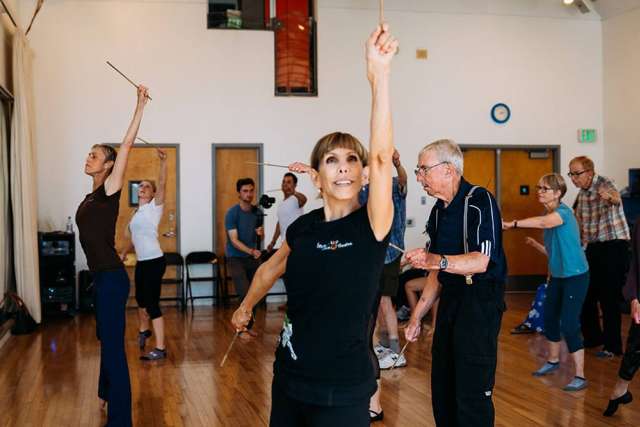What if your doctor told you all you have to do to decelerate the progression of Parkinson’s disease was turn on some music and two-step your way to better health? Would you do it?
Whether we have two left feet or we consider ourselves to be Fred Astaire or Ginger Rogers on the dance floor, music makes us move and groove, from a simple head bop to tap dancing or hip-hop.
However, a Canadian study released in July revealed that dancing to music is more powerful than we might think.
Between 2014 and 2017, researchers at York University monitored 16 people with an average age of 69 who all had been diagnosed with mild cases of Parkinson’s disease (PD). The participants attended weekly dance classes for three years. During that time, they experienced an improvement in speech, reduction in tremors, better balance and decreased rigidity.
The researchers also tracked 16 non-dancers, with similar Parkinson’s diagnoses, who did not see any improvements during the three-year period.
Dr. Jeff Bronstein, a neurologist at UCLA Health who specializes in movement disorders, is not surprised by the outcome of the research. A patient of his, Linda Berghoff, co-founded the Dancing Through Parkinson’s program in 2010. They both know firsthand the benefits of dance in combating Parkinson’s.
“There’s a science behind it,” Dr. Bronstein said. “There have been some studies over the last two decades that suggested that physical activity delays the symptoms in Parkinson’s disease.

“This study addressed the fact that if one person danced once a week over the span of three years, then their Parkinson’s progressed slower than those who did not dance,” he said,
Berghoff, who was diagnosed with Parkinson’s in 2006, said dance is the only variable she can think of that has helped her slow the progression of the disease.
“When I was diagnosed, the doctor told me, ‘You’ve danced all your life. You’re going to do better than most. You’re going to progress slowly,’” she said. “Initially, I didn’t believe him. I’ve had it for 16 years now, so maybe there’s something to this dance thing. My PD is progressing, but it is progressing slowly.”
Dr. Bronstein said dancing does produce positive outcomes when it comes to balance and cognitive functions because it is based on memorizing multiple patterns of movement.
However, dancing is just one form of exercise that will benefit people with Parkinson’s.
“I try to help my patients find the activity they enjoy doing and then help them become consistent with that one,” he said.
“There have been a variety of exercise studies that were linked to finding ways to slow symptoms of Parkinson’s, like high-intensity bicycle riding,” he said. “Boxing is a real common one, as is interval training.”
What is Parkinson’s?
Parkinson’s is a progressive disease that develops when nerve cells in the brain die or become impaired. These nerve cells are no longer able to produce dopamine, a neurotransmitter in the brain that helps the brain communicate. The loss of dopamine leads to a loss of movement in people with Parkinson’s.
Those with Parkinson’s also may develop problems with breathing, digestion, heart rhythm and blood pressure.
Often, the beginning stages of Parkinson’s may be hard to identify, but the following symptoms are usually associated with PD:
- Tremors in hands, fingers, chin or feet
- Rigid muscles or stiff limbs
- Spasms
- Dizziness or fainting
- Unsteady balance
- Loss of smell
- Decreased facial expression
Parkinson’s disease and dance
The Canadian researchers studied how weekly dance classes affected the motor and non-motor skills of each of their 16 participating patients. Motor skills were assessed before each class so that researchers could gauge whether there was a decline in progress or if progress was being made.
Researchers tested for motor features such as stiffness, rigidity and tremors. They also tested for non-motor features such as depression, hallucinations and other cognitive issues such as memory loss.
Their research showed that the 16 participants showed no deterioration over the three-year period, while the other 16 – those who did not participate in the dance classes – experienced a decline in their motor skills.
‘Dancing Through Parkinson’s’
Berghoff was in New York visiting her children and grandchildren when she heard about dance classes being offered through the renowned Mark Morris Dance Group for people who had been diagnosed with Parkinson’s disease.
“I walked in thinking it was going to be a normal class,” said Berghoff. “It wasn’t. It was a big room with about 60 people in the class. They put us in pairs. There were some in wheelchairs, some with walkers and some coming in ambulating like me. The teacher came in, put music on and led a series of modified dance warm-ups which allowed everyone to participate, even those in wheelchairs.”
The experience was life-changing for Berghoff. It gave her a new sense of hope, purpose and an idea that would change the future for Parkinson’s patients in California who wanted to dance.
“You felt like you were transported to another artistic realm. At the end of class, everybody had a joy that they did not have at the beginning of class,” she said. “I thought, ‘This is magical.’”
The experience moved Berghoff in such a way that she came back to California and told friend Laura Karlin, founder and artistic director of Invertigo Dance Theatre in Los Angeles. The two went back to New York with a few dancers from Karlin’s dance company, where they were trained in the art of teaching dance to people with Parkinson’s.
“They started everything,” Berghoff said of the Mark Morris Dance Company. “They began training us that year and since then they’ve been training people all around the world.”
Why is dancing so effective in slowing Parkinson’s?
Berghoff recalled the painful sight of watching her mother battle with Parkinson’s and feared that would be her situation too. However, she believes that dancing has made it a much more manageable fight due to its multiple benefits.
“With dance, you get the element of exercise, but you also get balance and flexibility,” said Berghoff. “You deal with strength in your movement and you have the element of choreography where you have to remember sequences of dance and movement. It’s not just physical. It’s mental. It’s cognitive because you’re remembering things. And there’s the element of artistic expression, which brings grace to people with a movement disorder”
Berghoff and Karlin eventually launched Dancing Through Parkinson’s, their own dance program for people with Parkinson’s. The nonprofit, going strong for more than a decade with funding from donations, is free to attend.
Dancing Through Parkinson’s is one of several programs under the umbrella of the Invertigo Dance Theatre. It holds classes throughout Los Angeles County including in Venice, Inglewood, Beverly Hills, Culver City and Tarzana. Berghoff, who is on the board of Dancing Through Parkinson’s along with Dr. Bronstein, also teaches some of the classes.
“I’m not a professional dancer, but I have Parkinson’s so I do understand the problems some of the participants may have with movement,” said Berghoff. “Participants can attend by themselves, or with a family member or a caregiver.”
She said she prides herself on running the Dancing Through Parkinson’s program as a legitimate class. “It’s a real dance class,” she said. “It’s not physical therapy. It’s modified, adapted and taught in such a way that everyone can do it. We do ballet, hip-hop, Latin and all sorts of other forms of dance.”
Berghoff is equally passionate about having Dancing Through Parkinson’s expand into underserved areas of Southern California.
“We want to serve the people because Parkinson’s is one of the biggest growing diseases right now,” she said, “and a lot of people are being diagnosed and don’t know what to do.”
According to the Parkinson’s Foundation, roughly 60,000 Americans are diagnosed with the disease yearly and more than 10 million people are living with Parkinson’s globally, about 1 million in the U.S.
If you or someone you know with Parkinson’s disease is interested in learning more about Dancing Through Parkinson’s, visit Invertigo Dance Theatre.
Visit the UCLA Health Movement Disorders Program to learn more about Parkinson’s disease or to contact someone from the UCLA Health Neurology team.




